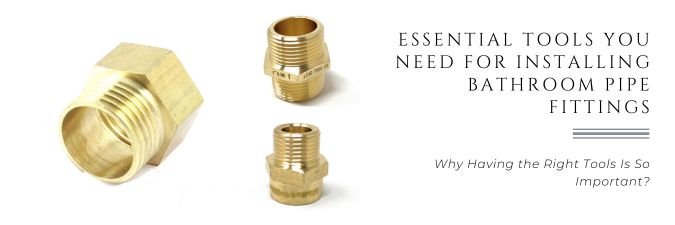Are you going to renovate your Bathroom? Perhaps you are building a new Shower System, replacing your Sink, or performing some plumbing repairs. No matter what you're doing, having the correct equipment is essential for completing tasks without undue stress. Cascada Showers recognizes that with the right tools, your DIY project can run smoothly rather than becoming a plumbing nightmare. Let us take a look at the important tools you'll need.
Why Having the Right Tools Is So Important?
Consider cooking: you wouldn't prepare a dish unless you have the proper ingredients, right? The same applies to plumbing. Using the right equipment allows you to properly install your bathroom Pipe Fittings, resulting in fewer leaks and annoyance down the line. Furthermore, it simplifies the job—you'll save time, feel less pressured, and get greater outcomes.
-
Pipe Wrench
This is your go-to tool for gripping and turning pipes, especially when those fittings are a little stubborn. If you’re dealing with bathroom pipe fittings, a good pipe wrench is a must. It is ideal for tightening or loosening difficult-to-move pipe connectors.
-
Cutter for Pipes
Doing work with PVC or metal pipes? A pipe cutter will be needed. Its purpose is to create precise, clean cuts that are necessary for joining pipes in the right way. Cutting new pipes or modifying old ones is considerably simpler when you have a pipe cutter.
Types of Pipe Cutters:
- Ratchet-style: Ideal for PVC and plastic pipes.
- Copper Pipe Cutter: For cutting copper pipes.
- Tubing Cutter: Best for smaller, delicate pipes.
Pick the right one for the job, and you’ll get smooth cuts every time.
-
Adjustable Wrench
When you’re dealing with bathroom fittings, an adjustable wrench is essential. Unlike the pipe wrench, which grips round pipes, this wrench is great for flat-sided nuts and bolts, like those on faucets or compression fittings. It’s one of those tools you’ll use again and again.
-
Teflon Tape
Do not overlook Teflon tape (also known as plumber's tape). This little gadget is essential for making leak-free threaded connections. Wrapping it around the threads of your fittings before screwing them together can result in a much better seal. Leaks are never enjoyable to deal with after the fact!
-
The Wrench for the Basin
Have you ever tried to loosen or tighten the nuts under a sink? Not a very comfortable task. Here's where a basin wrench comes in handy. Its big handle and swiveling jaw come in useful when you're working in tight spots under your bathroom sink. I guarantee you'll be pleased to have it.
-
The Reciprocating Saw
Sometimes, a pipe cutter just isn't meant to be utilized. A hacksaw is the best tool to use when working with larger or stronger pipes. Owing to its adaptability, it can make cuts through materials that a conventional cutter cannot, such as metal and PVC pipes. It is helpful to always have one on hand in case of such challenging circumstances.
-
Pipe Deburring Tool
Assembling pipes can be difficult because burrs, or rough edges, are often left over after cutting them. If the edges are smoothed with a pipe deburring tool, every component will fit snugly. While this may not seem like a big deal, it is an essential step to ensure a secure connection and prevent leaking.
-
Putty for Plumbers
Plumber's putty is the best material to cover gaps around non-threaded fittings, such as faucets or drains. This moldable compound keeps everything dry and stops leaks around fixtures by sealing the area tightly. It’s a small but essential item to have on hand.
-
Pipe Threading Tool
A pipe threading tool is ideal for creating unique threads on metal pipes. It won't be necessary for every project, but it's great for threading bespoke pipe lengths. It lets you create threads on the ends of pipes so they may be securely linked to fittings.
-
Plunger
A plunger may appear to be a simple tool, yet it is a bathroom requirement. Clogs do happen, and you'll be glad to have one on hand. When dealing with a clogged toilet or slow drain, your first line of defense should be a good plunger. Without one, never begin a bathroom makeover!
Conclusion
Bathroom pipe fitting installation doesn't have to be difficult, especially if you have the correct equipment. At Cascada Showers, we believe that with a little preparation and the right equipment, almost any bathroom plumbing project can be successfully finished. If your toolbox has important equipment such as plumber's putty, Teflon tape, pipe wrenches, and pipe cutters, you will be prepared for any challenges that your renovation job may present. So go ahead and begin working on your bathroom remodel.
FAQ: Essential Tools for Installing Bathroom Pipe Fittings
Q1: Can I use a regular wrench instead of a pipe wrench?
You could, but a pipe wrench gives you way better grip on round pipes, making the job much easier without risking slipping.
Q2: Is every pipe fitting going to require Teflon tape?
Sure, for fittings with threads! Teflon tape contributes to a leak-proof connection. However, since compression fittings seal in different ways, you won't require it.
Q3: What can I do in the event that I am without a pipe cutter?
In a bind, an old hacksaw will do. Just make sure that, subsequently, you use a deburring tool to polish the edges to ensure proper assembly.
Q4: How can I stop leaks after installing bathroom plumbing fixtures?
Ensure that all of your pipes are neatly cut and deburred, tighten everything, and use Teflon tape as needed. These steps help prevent leaks.
Q5: Do I need a pipe threading tool for all plumbing projects?
Not for most DIY jobs. Most pipes come pre-threaded. You’ll only need a threading tool if you’re cutting custom lengths that need threading.

